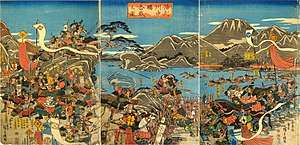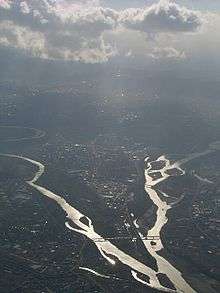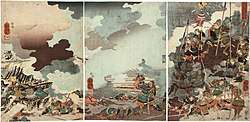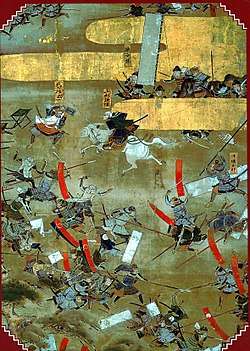Battles of Kawanakajima
The battles of Kawanakajima (川中島の戦い, Kawanakajima no tatakai) were fought in the Sengoku period of Japan between Takeda Shingen of Kai Province and Uesugi Kenshin of Echigo Province in the plain of Kawanakajima, Nagano, "the island between the rivers", in the north of Shinano Province.[1][2] The location is in the southern part of the present-day city of Nagano. Five major battles took place there: Fuse in 1553, Saigawa in 1555, Uenohara in 1557, Hachimanbara in 1561, and Shiozaki in 1564.[3] The best known and most severe among them was fought on October 18, 1561, and was only fought in the heart of the Kawanakajima plain, thus being the "battle of Kawanakajima".[3] The battles were fought after Shingen conquered Shinano, expelling Ogasawara Nagatoki and Murakami Yoshikiyo, who subsequently turned to Kenshin for help.[4] The battles became one of the most cherished tales in Japanese military history, the epitome of Japanese chivalry and romance, mentioned in epic literature, woodblock printing, and movies.[3]
| Battles of Kawanakajima | |||||||
|---|---|---|---|---|---|---|---|
| Part of the Sengoku period | |||||||
 The battle of Kawanakajima, Shingen on the left and Kenshin on the right; woodblock print by Utagawa Hiroshige (1845) | |||||||
| |||||||
| Belligerents | |||||||
| Takeda clan | Uesugi clan | ||||||
| Commanders and leaders | |||||||
| Strength | |||||||
| 4th battle: 20,000 | 4th battle: 18,000 | ||||||
| Casualties and losses | |||||||
| 4th battle: 3,000+ | 4th battle: 4,300+ | ||||||
Background
The battles were part of the 16th-century Sengoku period, also known as the "Age of Civil War", and were little different from other conflicts. After the Ōnin War (1467–77), the shōgun's system and taxation had increasingly less control outside the province of the capital in Kyoto, and powerful lords (daimyōs) began to assert themselves. Such lords gained power by usurpation, warfare or marriage—any means that would safeguard their position. It was manifested in yamajiro ("mountain castles"), which overlooked the provinces.[5]
In 1541, Shingen began his conquest of Shinano Province. In 1550, Shingen advanced once again into Shinano and quickly conquered Hayashi Castle, Kiribara and Fukashi Castle by siege. These had been controlled by Ogasawara Nagatoki, who fled to Murakami Yoshikiyo. In October 1550, Shingen began the Sieges of Toishi Castle, from which position he intended to carry out the final attack on the main Murakami castle of Katsurao. However, in November the siege was abandoned and Shingen's army was counterattacked by Murakami, and almost routed. The following year, though, Murakami was forced to leave the castle and the successful Siege of Katsurao (1553) ensued.[6]
First battle
The first battle of Kawanakajima, also known as the "Battle of Fuse", was fought in 1553. Although regarded as the first battle, it is related to the two battles of Hachiman fought in the same year south of the plain.[7]
Twelve days after taking Katsurao Castle, Shingen penetrated far into the Kawanakajima plain along the eastern bank of the Chikumagawa River. Uesugi Kenshin marched up the western bank to support Murakami Yoshikiyo, and the two armies encountered each other at a shrine of Hachiman (place within modern Yashiro) on June 3, 1553. After Takeda withdrew, Uesugi continued his march and laid siege to Katsura, but was unable to capture it.[8]:212
In September Takeda returned to crush the remaining Murakami forces around Shioda. Wada was taken on September 8 and Takashima on the 10th. In both cases the entire garrison was put to death as a warning to other Murakami holdouts. Murakami Yoshikiyo retreated from Shioda on 12 September and about 16 of the clan's outposts in Shinano surrendered to Takeda. Shingen pursued Yoshikyo across the Chikumagawa River but was turned back by Kenshin's reinforcements at the Battle of Fuse. Kenshin pursued Shingen, winning another battle at Hachiman. The victorious Uesugi forces went on take Arato castle before winter forced both sides to disengage.
Second battle

From August to November 1555 the second battle of Kawanakajima, also known as the "Battle of Saigawa", began when Takeda Shingen returned to Kawanakajima, advancing up to the Sai River. He made camp on a hill to the south of the river, while Uesugi Kenshin was camped just east of the Zenkō-ji temple, which provided him an excellent view of the plain. However, the Kurita clan, allies of the Takeda, held Asahiyama fortress a few kilometers to the west; they menaced the Uesugi right flank. Kurita Kakuju's defenses were bolstered by 3,000 Takeda warriors, of whom 800 were archers and 300 arquebusiers.[2][8]:213
The main battle was almost shadowed by the number of Kenshin's attacks (siege) against the Asahiyama fortress,[9] but all were repulsed. Eventually he moved his army onto the plain, redirecting his attention to Takeda's main force. However, rather than attacking, both armies waited, for months, for the other to make a move. Finally, battle was avoided as both leaders retired to deal with domestic affairs in their home provinces.[8]:213–215 The peace was mediated by Imagawa Yoshimoto.[10]
Third battle
The third battle, also known as the "Battle of Uenohara",[9] took place in 1557 when Takeda Shingen captured a fortress called Katsurayama, overlooking the Zenkō-ji temple from the northwest. He then attempted to take Iiyama castle, but withdrew after Uesugi Kenshin led an army out of Zenkō-ji.[2][8]:215 Of the four, this battle took place furthest from the Kawanakajima plain.[7]
Fourth battle
The fourth battle resulted in greater casualties for both sides, as a percentage of total forces, than any other battle in the Sengoku period and is, according to Turnbull, one of the most tactically interesting battles of the period.[11]
After besieging the Hōjō Ujiyasu's Odawara castle, Uesugi Kenshin was forced to withdraw after hearing rumors about the movement of Takeda Shingen's army.[6] In September 1561 Kenshin left his Kasugayama Castle with 18,000 warriors, determined to destroy Shingen. He left some of his forces at Zenkō-ji but took up a position on Saijoyama, a mountain to the west of, and looking down upon, Shingen's Kaizu castle. To Kenshin's ignorance, the Kaizu castle contained no more than 150 samurai and their followers and he had taken them completely by surprise. However, the general in command of the castle, Kosaka Masanobu, through a system of signal fires, informed his lord, in Tsutsujigasaki fortress, 130 km away in Kōfu, of Kenshin's move.[8]:269

Shingen left Kōfu with 16,000 men, acquiring 4,000 more as he traveled through Shinano Province, approaching Kawanakajima on the west bank of the Chikumagawa (Chikuma River), keeping the river between him and Saijoyama. "Neither army made a move", knowing that victory would require the essential element of surprise. Shingen was thus allowed into his fortress at Kaizu along with his gun-bugyō (army commissioner), Yamamoto Kansuke. At that time Kansuke formed a strategy that he believed would prove effective against Kenshin.[8]:270–271
Kōsaka Masanobu left Kaizu with 8,000 men, advancing up Saijoyama under cover of night, intending to drive Kenshin's army down to the plain where Takeda Shingen would be waiting with another 8,000 men in kakuyoku ("crane's wing"), formation. However, whether via spies in Kaizu or scouts looking down from Saijoyama, Kenshin guessed Shingen's intentions and led his own men down to the plain. Kenshin descended from Saijoyama by its western flanks. Instead of fleeing Kosaka's dawn attack, Uesugi Kenshin's army crept down the mountain, quietly using bits of cloth to deaden the noise of their horses' hooves. With the beginning of dawn, Shingen's men were surprised to find Kenshin's army ready to charge at them—as opposed to fleeing from the mountain, as expected.[8]:271
Uesugi's forces attacked in waves, in a kuruma gakari formation, in which every unit is replaced by another as it becomes weary or destroyed. Leading the Uesugi vanguard were two of Uesugi's "Twenty-Eight Generals", Kakizaki Kageie and Irobe Katsunaga.[12] Kakizaki's unit of mounted samurai clashed with Takeda Nobushige's unit, resulting in the death of Nobushige. While the kakuyoku formation held surprisingly well, the Takeda commanders eventually fell, one by one. Seeing that his pincer plan had failed, Yamamoto Kansuke charged into the enemy ranks, being killed in action with his two chief retainers, Osaragi Shōzaemon and Isahaya Sagorō.[8]:271

Eventually the Uesugi forces reached the Takeda command post, and one of the most famous single combats in Japanese history ensued. Uesugi Kenshin himself burst into the headquarters, attacking Takeda Shingen who, unprepared for such an event, parried with his signalling fan as best as he could, and held Kenshin off long enough for one of his retainers, Hara Osumi-no-Kami, to spear Kenshin's mount and drive him off.[8]:271–272
The Takeda main body held firm, despite fierce rotating attacks by the Uesugi. Obu Saburohei fought back against Kakizaki's samurai. Anayama Nobutada destroyed Shibata Harunaga of Echigo, and forced the Uesugi main force back to the Chikumigawa.[8]:272
Meanwhile, Kosaka's stealth force reached the top of Saijoyama and, finding the Uesugi position deserted, hurried down the mountain to the ford, taking the same path they had expected the fleeing Uesugi to take. After desperate fighting, they punched their way through the 3000 Uesugi warriors defending the ford (under the command of Uesugi general Amakasu Kagemochi), and pressed on to aid Takeda's main force. The Kosaka force then attacked the retreating Uesugi from the rear. Takeda Shingen's many great generals, including his younger brother Takeda Nobushige and Murozumi Masakiyo, were killed in the field.[8]:272
Result
In the end, the Uesugi army suffered 72% casualties, while the Takeda lost 62%. The chronicles seem to indicate that the Takeda made no effort to stop the Uesugi from retreating after the battle, burning the encampment at Saijoyama, returning to Zenkō-ji and then to Echigo Province.[8]:272 Some more conservative estimates place the casualties around 20%.[13]
Fifth battle
In September 1564, Shingen and Kenshin met for the fifth time on the plain of Kawanakajima. Their forces skirmished for 60 days, and then both withdrew.[2][8]:217[14]
Another encounter near Lake Nojiri in 1568 could be labeled as the sixth battle, but it is not considered as such.[15]
References
- Turnbull 2013, p. 11.
- Turnbull, Stephen (1987). Battles of the Samurai. Arms and Armour Press. pp. 41–56. ISBN 0853688265.
- Turnbull 2013, pp. 7–8.
- Sato, Hiroaki (1995). Legends of the Samurai. Overlook Duckworth. pp. 214–220. ISBN 9781590207307.
- Turnbull 2013, pp. 8–11.
- Turnbull 2013, p. 12.
- Turnbull 2013, p. 8.
- Turnbull, Stephen (1998). The Samurai Sourcebook. Cassell & Co. pp. 212–217. ISBN 1854095234.
- Turnbull 2013.
- "第二次川中島の戦い(1555年)". Kantō Sengoku-shi. Retrieved February 8, 2018.
- Turnbull 2012, p. 35.
- Turnbull 2013, p. 76.
- Goldsmith 2008, p. 219.
- Sansom, George (1961). A History of Japan, 1334–1615. Stanford University Press. p. 246. ISBN 0804705259.
- Turnbull 2013, pp. 8, 12.
- Goldsmith, Brian (2008). Amassing Economies: The Medieval Origins of Early Modern Japan, 1450–1700. ProQuest. ISBN 9780549851158.CS1 maint: ref=harv (link)
- Turnbull, Stephen (2012). War in Japan 1467–1615. Bloomsbury Publishing. ISBN 9781782000471.CS1 maint: ref=harv (link)
- Turnbull, Stephen (2013). Kawanakajima 1553–64: Samurai Power Struggle. Bloomsbury Publishing. ISBN 9781472800220.CS1 maint: ref=harv (link)
External links
